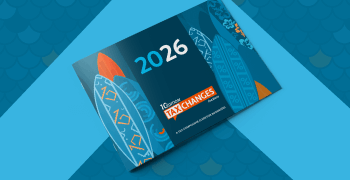
New HS codes create headaches for cross-border sellers
Cross-border sellers are dealing with new compliance hurdles as of January 1, 2021, thanks to tariff-code changes in Mexico and the United Kingdom, Brexit, and the U.K.’s new ecommerce package.
What are tariff codes?
Tariff codes identify products that move across international borders. They vary by product and destination, and are used to declare goods, calculate customs duties, and track what’s entering and exiting the country.
The United States and more than 200 other countries and economies use the Harmonized System (HS) created by the World Customs Organization (WCO) in 1988. It contains more than 5,000 commodity groups and more than 200,000 commonly traded commodities. Each product is identified, at a minimum, by a six-digit HS code that’s the same across all 200+ countries.
Although six digits is the global standard, HS codes frequently have eight to 10 digits or more because governments add numbers to further define and distinguish products. The extra numbers vary by country depending on the attributes they want to track. For example, the U.S. typically uses 10 numbers (called Harmonized Tariff Schedule codes or HTS codes). You can see examples and learn more about HS codes in Understanding international product classification through Harmonized System codes.
All goods shipped internationally must be assigned the correct, complete HS code so customs authorities in other countries can accurately identify and track imports as well as ensure the proper tariffs and import taxes are applied. Tariff rates are driven by HS codes, though the rates themselves are determined by other factors such as preferential treaties, punitive rates, country of manufacture, and different units of measure.
Assigning the wrong code could result in over- or undercharging customs duty and tax. It can also cause goods to be held at customs, delaying shipments and upsetting customers. Furthermore, misidentifying products could lead to administrative and legal penalties and even denial of import privileges for the seller.
Mexico’s HS codes get two new digits
Mexico has used eight-digit HS codes since the Harmonized System was created in 1988. As of December 28, 2020, Mexico’s HS codes must contain 10 digits. Mexico has also added new tariff codes for new products and eliminated codes for outdated (i.e., rarely traded) goods.
HS codes tend to be organic in nature because they identify ever-morphing products. The Harmonized System itself is updated every five years to account for new products and circumstances. The most recent changes, which came into force January 1, 2017, included 233 sets of amendments and inspired the overhaul of Mexico’s tariff system. The next overhaul, in 2022, will bring more big changes across countries.
It’s taken Mexico four years to fully implement the 2017 changes.
Under Mexico’s “New LIGIE” (Tarifa de la Ley de los Impuestos Generales de Importación y de Exportación), all shipments to Mexico must be labeled with the new 10-digit HS codes. The additional two digits will help Mexico better identify the movement of goods. It also brings Mexico’s classification system into closer alignment with the HTS used by Canada and the U.S.
Though a hassle, the changes to Mexico’s HS codes are for the most part straightforward and structural. What’s happening on the other side of the Atlantic is more complex.
Brexit leads to new UK Global Tariff
The U.K. created their new U.K. Global Tariff after Brexit, using the European Union’s integrated Tariff of the European Union (TARIC) system as a starting point.
The EU TARIC system integrates the standard six-digit HS codes with a two-digit Combined Nomenclature (CN) heading, and a two-digit country code. The six-digit HS codes are identical across all EU member states, as in other countries, and the other four digits vary by country.
Shipments between EU member states are typically identified with an abbreviated eight-digit HS code. Now, that the U.K. has left the EU Customs Union, goods flowing between the U.K. and the EU need the full 10-digit HS code. The U.K. can no longer use the simplified (i.e., eight-digit) TARIC system when trading with EU member states.
As of January 1, 2021, the U.K. Global Tariff (UKGT) system is in effect for all jurisdictions in the U.K. The UKGT applies to any goods shipped into the U.K.; preferential rates and exemptions are part of the tariff.
Under the UKGT, many tariffs for existing HS codes changed, and new HS codes were implemented for shipments moving between the U.K. and EU.
Inventory in UK can lead to double duties
Because of Brexit, the U.K. is no longer eligible for many customs and value-added tax (VAT) simplification measures open to the remaining 27 EU member states. This, in turn, affects U.S. companies using the U.K. as a launchpad for selling into the EU.
Only goods originating (i.e., manufactured, or where >51% of the value was added) in the U.K. are subject to preferential tariff treatment in the EU under the Brexit deal reached December 24, 2020. Thus, goods shipped into the U.K. for later distribution throughout the EU may now be taxed twice: once upon entry into the U.K., and once when entering the destination country. However, businesses can request a refund of the import tariffs originally levied, provided they furnish proof the goods left the country.
This is a big change, and a costly one for many ecommerce sellers.
There are two potential remedies. One is to import goods destined for delivery in the EU directly into the EU. Another is to store goods in a bonded (customs) warehouse in the U.K. that is supervised by customs authorities. Using a bonded warehouse enables businesses to defer paying duty and tax until the goods are shipped to a buyer.
Companies currently holding inventory in the U.K. need to ensure they comply with all new regulations. Goods shipped from the U.K. to destinations in the EU now must be declared to customs with full EU HS codes and will be subject to all applicable customs duties and import VAT in the buyer’s home country — or, if entering the EU through a different port, that country’s rates.
New VAT on low-value imports to the UK
Further complicating matters, as of January 1, 2021, the new U.K. ecommerce package imposes new VAT collection and reporting requirements on online sellers based outside of the U.K.:
- The VAT exemption for parcels valued ≤£15 is eliminated (i.e., all imports are subject to VAT)
- VAT must be collected at checkout and remitted directly to HM Revenue and Customs (HMRC) for all imported sales valued ≤£135 (duty and VAT on sales valued >£135 continue to be collected at the border)
- Online marketplaces (OMPs) must collect VAT at checkout (and remit directly to HMRC) on imported sales valued ≤£135 and all U.K. transactions by overseas sellers (as above, duty and VAT on sales valued >£135 are collected at the border)
Additionally, businesses need a U.K. Economic Operator Registration and Identification (EORI) number to import or export goods into the U.K., and an EU EORI number to import or export goods from the 27 EU member states. Without a valid EORI number, goods will be held at customs. EORI numbers are connected to a seller’s VAT number(s).
The perfect-storm scenario has flooded U.S. sellers with new tax collection and reporting obligations, and a veritable tsunami of paperwork.
According to Richard Asquith, vice president of global indirect tax at Avalara, the elimination of the import VAT exemption for goods valued ≤£15 caught a lot of ecommerce sellers off guard, as did the U.K.’s new requirement that VAT must be collected at checkout for all goods valued £135 or less. “This created huge problems in the first week of January, particularly for U.S. and Chinese sellers who were unaware” of the policy changes.
Border and customs officials and HMRC seem to be “prioritizing the continuing movement of goods over maximizing revenues” for the moment. That will change. Already, Asquith says, “We’re starting to hear of goods being blocked.”
Adapting to new requirements is hard. Automating tax compliance can help.
The above changes illustrate why automating HS code configuration can be so beneficial to businesses. Simply put, using incorrect HS codes can bungle cross-border sales.
Failure to collect enough customs duty or import tax from customers can cut into already slim margins, as sellers often end up paying the difference themselves. Alternatively, it can spring unexpected costs on customers, even with gifts. It can also lead to fines and penalties — and worse, if customs agents suspect it was intentional fraud.
Avalara assigns country-specific HS codes to products using an efficient and affordable solution. Learn more at avalara.com/classification.

Avalara Tax Changes 2026 is here
The 10th edition of our annual report engagingly breaks down key policies related to sales tax, tariffs, and VAT.
Stay up to date
Sign up for our free newsletter and stay up to date with the latest tax news.














